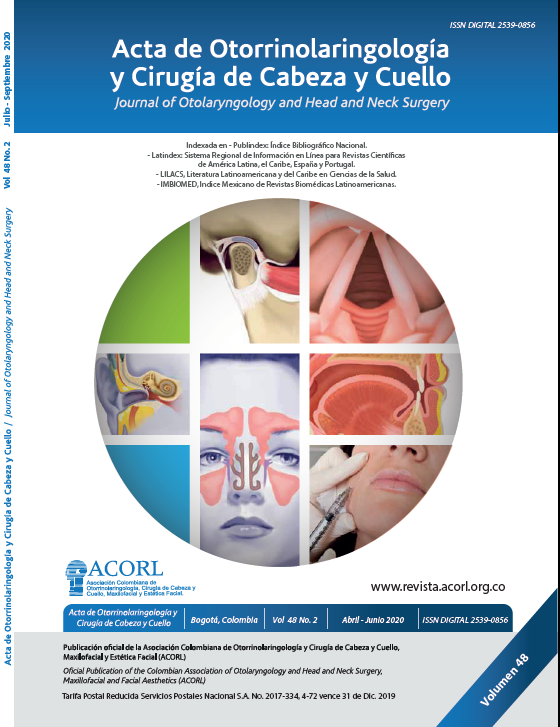Characterization of dysphonia in pediatric age in a laryngology center in Bogotá, Colombia.
Main Article Content
Abstract
Dysphonia is present in 6 to 23% of children between 4-12 years of age and its study suppose a diagnostic and therapeutic challenge because the procedures currently used require a complete collaboration from de patient. In Colombia, a study on the characterization of the main pathologies that cause dysphonia in children has not been carried out so far. Vocal nodules are not the main cause of dysphonia in children in our population.
This is an observational study where a revision of clinical histories and stroboscopies of patients younger than 18 with chronical voice symptoms (greater than 4 weeks) that assisted to a laryngology consultation within the last 10 years was done. A statistical and descriptive analysis was made with the collected data. 141 patients were selected, 73% had bilateral vocal fold lesions, 9.9% unilateral lesions and 16.3% had primary muscle tension dysphonia. The most common finding was vocal sulcus (13.37%), followed by muscle tension dysphonia and vocal nodules (13.2%). 41.06% of patients referred vocal abuse, and within this group, vocal nodules where most prevalent.
This is the first study in Colombia and the second one in Latin America of its kind. The results are generally consistent with the literature, except that in this study, the first cause of dysphonia is vocal sulcus, as opposed to vocal nodules which are typically the most common cause. There was a relation between chronic voice abuse, vocal nodules and cysts, this supports the theory that cysts are acquired lesions and not congenital.
Downloads
Article Details
Este artículo es publicado por la Revista Acta de Otorrinolaringología & Cirugía de Cabeza y Cuello.
Este es un artículo de acceso abierto, distribuido bajo los términos de la LicenciaCreativeCommons Atribución-CompartirIgual 4.0 Internacional.( http://creativecommons.org/licenses/by-sa/4.0/), que permite el uso no comercial, distribución y reproducción en cualquier medio, siempre que la obra original sea debidamente citada.
eISSN: 2539-0856
ISSN: 0120-8411
References
Stachler RJ, Francis DO, Schwartz SR, Damask CC, Digoy GP, Krouse HJ, et al. Clinical Practice Guideline: Hoarseness(Dysphonia) (Update). Otolaryngol Neck Surg. 2018;158(3):409-
https//doi.org/10.1177/0194599817751031
Martins RHG, Hidalgo Ribeiro CB, Fernandes de Mello BMZ, Branco A, Tavares ELM. Dysphonia in Children. J Voice.2012;26(5):674.e17-674.e6.74E20. https//doi.org/10.1016/j.jvoice.2012.03.004
Choi SS, Zalzal GH. Voice disorders in children. En: Cummings Otolaryngology, Head & Neck Surgery. 6.a ed. Filadelfia:Elsevier; 2015. p. 3133–41.
Gray SD, Smith ME, Schneider H. VOICE DISORDERS IN CHILDREN. Pediatr Otolaryngol. 1996;43(6):1357-1384.
https//doi.org/10.1016/s0031-3955(05)70523-x
Levitsky SE. Hoarseness. En: Primary pediatric care. 4.a ed. St.Louis: Mosby; 2001. p. 1156.
Yang J, Xu W. Characteristics of Functional Dysphonia in Children. J Voice. 2020;34(1):156.e1-156.e4. https//doi.
org/10.1016/j.jvoice.2018.07.027
Angelillo N, Di Costanzo B, Angelillo M, Costa G, Barillari MR, Barillari U. Epidemiological study on vocal disorders in paediatric age. J Prev Med Hyg. 2008;49(1):1-5.
Connelly A, Clement WA, Kubba H. Management of dysphonia in children. J Laryngol Otol. 2009;123(6):642–7. https//doi.org/10.1017/S0022215109004599
Toohill RJ. The Psychosomatic Aspects of Children With Vocal Nodules. Arch Otolaryngol. 1975 Oct;101:5. https//doi.org/10.1001/archotol.1975.00780390005002
Wilson DK. Children with Vocal Nodules. J Speech Hear Disord. 1961;26(1):19–26.
Batza EM. Vocal Cord Nodules in Children: Pathogenesis, Clinical Manifestations, Therapy. Clin Pediatr (Phila).
;9(1):14–6. https//doi.org/10.1177/000992287000900105
Kay NJ. Vocal nodules in children - aetiology and management. J Laryngol Otol. 1982;96:731–6. https//doi.org/10.1017/ s0022215100093051
Martins RHG, do Amaral HA, Tavares ELM, Martins MG, Gonçalves TM, Dias NH. Voice Disorders: Etiology and
Diagnosis. J Voice. 2016;30(6):761.e1-761.e9. https//doi. org/10.1016/j.jvoice.2015.09.017
Nardone HC, Recko T, Huang L, Nuss RC. A Retrospective Review of the Progression of Pediatric Vocal Fold Nodules. JAMA Otolaryngol Neck Surg. 2014;140(3):233. https//doi. org/10.1001/jamaoto.2013.6378
Nunes RB1, Behlau M, Nunes MB, Paulino JG. Clinical diagnosis and histological analysis of vocal nodules and
polyps. Braz J Otorhinolaryngol. 2013;79:434–40. https//doi. org/10.1001/jamaoto.2013.6378
Teachey JC, Kahane JC, Beckford NS. Vocal mechanics in untrained professional singers. J Voice. 1991;5(1):51–6.
Qua CS, Wong CH, Gopala K, Goh KL. Gastro-oesophageal reflux disease in chronic laryngitis: prevalence and
response to acid-suppressive therapy. Aliment Pharmacol Ther. 2007;25(3):287-295. https//doi.org/10.1111/j.1365-2036.2006.03185.x
Kahrilas PJ, Shaheen NJ, Vaezi MF. American Gastroenterological Association Medical Position Statement
on the Management of Gastroesophageal Reflux Disease. Gastroenterology. 2008;135(4):1383-1391.e5. https//doi.org/10.1053/j.gastro.2008.08.045
Hopkins C, Yousaf U, Pedersen M. Acid reflux treatment for hoarseness. Cochrane Database Syst Rev. 2006;(1):CD005054. https//doi.org/10.1002/14651858.CD005054.pub2

